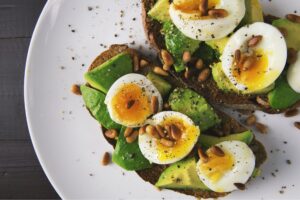BLOG:
7 Tips for Losing Body Fat Without Losing Muscle

So, you’ve been working hard to put on muscle and get stronger, and now you want to lose some fat. But how can you lose body fat without undoing all your hard work? While weight loss often leads to losing both lean and fat mass, there are some steps you can take that can help you lose body fat without losing muscle mass.
Body recomposition – the process of losing fat while gaining or maintaining muscle – is achieved through a lifestyle change that focuses on a balanced diet with adequate protein, carbohydrates and healthy fats, while also consistently strength training. With the right approach, it is possible to achieve body recomposition over time!
Weight Loss vs. Fat Loss
Weight loss refers to a decrease in overall body weight, which can include a combination of fat, water, and muscle loss. However, it can be difficult to know whether you are losing weight from fat or muscle. On the other hand, fat loss specifically targets body weight reduction with a focus on reducing fat.
Contrary to popular belief, your ratio of muscle to fat is actually a better indicator of health than your weight. Having a healthy muscle to fat ratio not only helps you look and feel better but it also reduces your risk of a number of chronic health conditions.
While a scale can be used to track weight loss progress, it does not indicate whether the weight loss is coming from fat or muscle. To track fat losss progress, rather than focusing on your weight, you should focus on your body’s circumference measurements (you’ll particularly see changes in your waist and stomach measurements), your body fat percentage, and lean mass. You can measure and track all of these through the Bodymapp 3D body scanning app.
How to lose body fat without losing muscle
To achieve fat loss, it’s important to create a calorie deficit. This can be done by reducing calorie intake and incorporating regular exercise. However, solely relying on calorie restriction without exercise can result in the loss of both muscle and fat.
Maintaining muscle mass while losing fat – AKA body recomposition – is a common goal for those looking to improve overall health and fitness. It’s crucial to focus on body composition rather than just the number on the scale. By preserving muscle mass, you can ensure that you are losing primarily fat. This is important because muscle mass plays a vital role in maintaining strength, endurance, and metabolism.
Here are some tips for losing fat while preserving lean muscle mass:
1. Eat in a calorie deficit
To lose fat, it’s important to create a calorie deficit. However, if calorie restriction is too drastic, it can lead to muscle loss as well as fat loss. You should eat at a slight calorie deficit of about 200-500 calories below your maintenance. You can use calorie calculators online to find this. Alternatively, you can look at your calorie benchmarks in your Bodymapp health report, find your lifestyle category for physical activity and take about 200-500 cals off your TDEE.
2. Eat a high protein diet
Protein is essential for maintaining a healthy body. It helps improve the immune system, boost energy levels, promote digestive health, and regulate fluid balance. Protein also plays an important role in muscle growth and maintaining muscle tissue. By increasing protein intake while in a calorie deficit, you can lose fat while maintaining muscle mass. You should aim for 1.2-2.2 grams of protein per kg of bodyweight daily.
3. Exercise regularly
Regular exercise is key to losing fat and preserving muscle mass. When combined with a calorie deficit, working out can help you lose fat while maintaining muscle. While cardio is essential for overall health and fat loss, strength training is also crucial for maintaining muscle mass. So, it’s important to include both cardio and strength training in your workout routine to maximise fat loss and muscle retention.
4. Eat a balanced diet
Eating a healthy, balanced diet is essential for achieving fat loss. This means consuming a variety of nutrient-dense foods, such as fruits and vegetables, lean proteins, wholegrains, and healthy fats. These foods provide the necessary nutrients for maintaining a healthy body, while also helping to keep you feeling full and satisfied.
It’s also important to limit processed foods, added sugars, and saturated fats, as these can negatively impact overall health. However, remember to not completely restrict yourself from these foods, as overly restrictive eating can lead to bingeing. Instead, allow yourself to indulge in moderation, and find a balance between healthy eating and allowing yourself to enjoy the foods you love. By finding a balance and not feeling deprived of your favourite foods, you are more likely to stick to a healthy eating plan in the long run and achieve your fat loss goals.
5. Remember to rest
Rest is essential for maintaining muscle mass because during rest the body repairs and rebuilds muscle tissue. When you exercise, you create small tears in your muscle fibres, and during rest, these fibres repair and grow stronger, leading to muscle growth. Adequate rest also helps to reduce muscle soreness and fatigue, allowing you to perform at your best during your next workout. Additionally, during rest, the body releases growth hormone and testosterone, which are essential for muscle growth and repair.
Skipping rest days or not getting enough sleep can lead to muscle loss, fatigue, and injury. Therefore, it’s crucial to include rest days in your workout routine, and also make sure to get enough sleep every night to allow your body to recover and build muscle mass.
6. Consistency is key
Losing body fat takes time and effort, so it’s important to stay consistent with your diet and exercise routine. Setting realistic goals and tracking progress can also help keep you on track. You can set goals and track your progress in the ‘Goals’ section of the Bodymapp app, or through methods like progress photos and measurements. Remember, you don’t need to be extreme – just consistent.
7. Patience is essential
Though I’m sure we’d all love it if we could achieve results overnight – rapid weight loss is often unsustainable! It’s important to lose weight slowly and steadily, especially if you’re trying to lose fat without losing muscle. Body recomposition a long-term process that requires patience and consistency. Make sure you focus on progress, not perfection. Instead of getting discouraged by setbacks, focus on the progress you have made and the progress yet to come.
Please keep in mind that the advice in this article is of a general nature and should not be relied on as professional advice. You should always consult your physician before beginning any diet, nutrition, or fitness plan.





